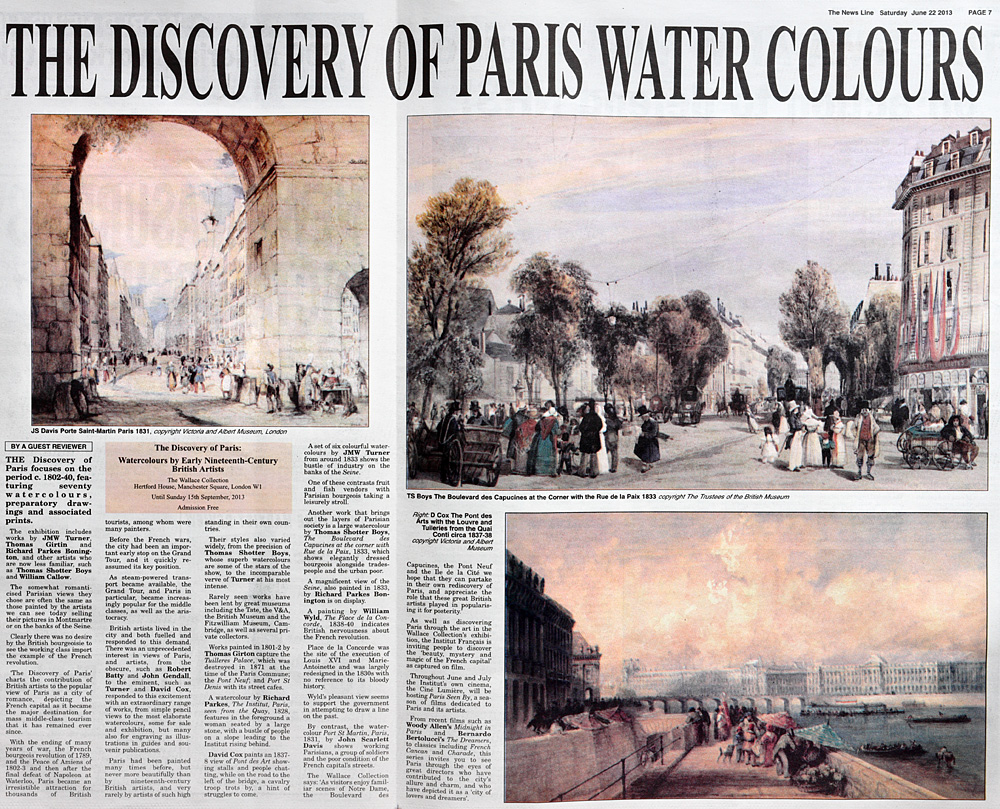 |
| The News Line Saturday June 22
2013 PAGE 7 THE DISCOVERY OF PARIS WATER COLOURS BY A GUEST REVIEWER The Discovery of Paris: Watercolours by Early Nineteenth-Century British Artists The Wallace Collection Hertford House. Manchester Square. London W1 Until Sunday 15th September. 2013 Admission Free THE Discovery of Paris focuses on the period c. 1802-40, featuring seventy watercolours, preparatory drawings and associated prints. The exhibition includes works by JMW Turner. Thomas Girtin and Richard Parkes Bonington, and other artists who are now less familiar, such as Thomas Shotter Boys and William Callow. The somewhat romanticised Parisian views they chose are often the same as those painted by the artists we can see today selling their pictures in Montmartre or on the banks of the Seine. Clearly there was no desire by the British bourgeoisie to see the working class import the example of the French revolution. 'The Discovery of Paris' charts the contribution of British artists to the popular view of Paris as a city of romance, depicting the French capital as it became the major destination for mass middle-class tourism that it has remained ever since. With the ending of many years of war, the French bourgeois revolution of 1789, and the Peace of Amiens of 1802-3 and then after the final defeat of Napoleon at Waterloo, Paris became an irresistible attraction for thousands of British tourists, among whom were many painters. Before the French wars, the city had been an important early stop on the Grand Tour, and it quickly reassumed its key position. As steam-powered transport became available, the Grand Tour, and Paris in particular, became increasingly popular for the middle classes, as well as the aristocracy. British artists lived in the city and both fuelled and responded to this demand. There was an unprecedented interest in views of Paris, and artists, from the obscure, such as Robert Batty and John Gendall, to the eminent, such as Turner and David Cox, responded to this excitement with an extraordinary range of works, from simple pencil views to the most elaborate watercolours, some for sale and exhibition, but many also for engraving as illustrations in guides and souvenir publications. Paris had been painted many times before, but never more beautifully than by nineteenth-century British artists, and very rarely by artists of such high standing in their own countries. Their styles also varied widely, from the precision of Thomas Shotter Boys, whose superb watercolours are some of the stars of the show, to the incomparable verve of Turner at his most intense. Rarely seen works have been lent by great museums including the Tate, the V&A. the British Museum and the Fitzwilliam Museum, Cambridge, as well as several private collectors. Works painted in 1801-2 by Thomas Girton capture the Tuilleres Palace. which was destroyed in 1871 at the time of the Paris Commune; the Pont Neuf; and Port St Denis with its street cafes. A watercolour by Richard Parkes, The Institut, Paris, seen from the Quay, 1828. features in the foreground a woman seated by a large stone, with a bustle of people on a slope leading to the Institut rising behind. David Cox paints an 1837- 8 view of Pont des Art showing stalls and people chatting, while on the road to the left of the bridge, a cavalry troop trots by, a hint of struggles to come. A set of six colourful watercolours by JMW Turner from around 1833 shows the bustle of industry on the banks of the Seine. One of these contrasts fruit and fish vendors with Parisian bourgeois taking a leisurely stroll. Another work that brings out the layers of Parisian society is a large watercolour by Thomas Shotter Boys, The Boulevard des Capucines at the corner with Rue de la Paix, 1833, which shows elegantly dressed bourgeois alongside trades people and the urban poor. A magnificent view of the Seine, also painted in 1833, by Richard Parkes Bonington is on display. A painting by William Wyld, The Place de la Concorde, 1838-40 indicates British nervousness about the French revolution. Place de la Concorde was the site of the execution of Louis XVI and Marie Antoinette and was largely redesigned in the 1830s with no reference to its bloody history. Wyld's pleasant view seems to support the government in attempting to draw a line on the past. By contrast, the watercolour Port St Martin, Paris, 1831, by John Scarlett Davis shows working Parisians, a group of soldiers and the poor condition of the French capital's streets. The Wallace Collection says: 'As visitors enjoy familiar scenes of Notre Dame, the Boulevard des Capucines, the Pont Neuf and the Ile de la Cite we hope that they can partake in their own rediscovery of Paris, and appreciate the role that these great British artists played in popularising it for posterity. As well as discovering Paris through the art in the Wallace Collection's exhibition, the Institut Francais is inviting people to discover the 'beauty, mystery and magic of the French capital' as captured on film. Throughout June and July the Institut's own cinema, the Cine Lumiere, will be hosting Paris Seen By, a season of films dedicated to Paris and its artists. From recent films such as Woody Allen's Midnight in Paris and Bernardo Bertolucci's The Dreamers, to classics including French Cancan and Charade, this series invites you to see Paris through the eyes of great directors who have contributed to the city's allure and charm. and who have depicted it as a 'city of lovers and dreamers'. http://www.wrp.org.uk |